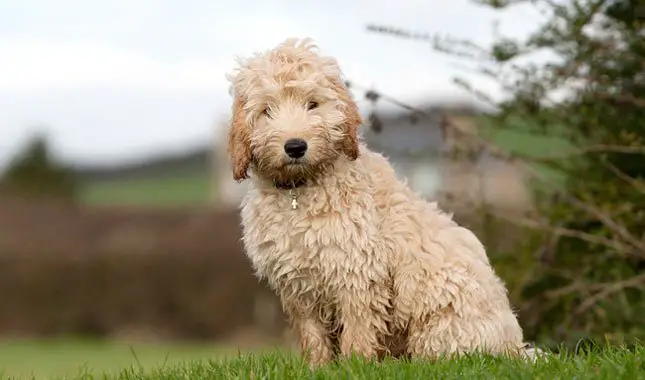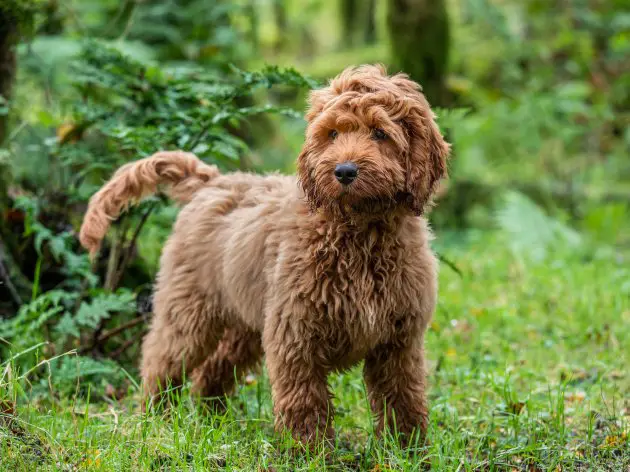Cockapoo is a crossbreed of an American and/ or English Cocker Spaniel and a Toy or Miniature Poodle. The first Cockapoo was due to accidental mating in the 1950s and is known as Spoodle in Australia and Cockadoodle in Sweden.
Cockapoo pups vary in appearance even within the same litter because no two Cockapoos are alike. No breeder can guarantee how a pup will turn out.
Be knowledgeable about the dog before splurging hundreds of dollars on a pup. This guide helps precisely with that. Read on.
Cockapoo Overview
| Height | Teacup: Under 10 inches Toy: Around 10 inches Miniature: 11 to 14 inches Maxi: At least 15 inches |
| Weight | Teacup: Under 6 pounds Toy: Around 12 pounds Miniature: 13 to 18 pounds Maxi: Over 20 pounds |
| Lifespan | 14-18 Years |
| Temperament | Happy, Outgoing, Friendly, People-oriented, Quirky, and Intelligent |
As mentioned above, the first Cockapoo resulted from accidentally mating a Cocker Spaniel and a Poodle in the 1950s. Intentional breeding accelerated in the 1960s to develop prize family companions and therapy dogs.
The Poodle and Cocker Spaniel are working dogs known for their active, intelligent, and even temperament. Additionally, Poodles bring the advantage of being low-shedding and are believed to be hypoallergenic. This isn’t exactly accurate.
It’s difficult to predict how this mix turns out, as most Cockapoos are first or second-generation crossbreeds.
For more consistent traits, different groups are working to standardize this breed. This led to Cockapoo-specific registries such as the American Cockapoo Club and the Cockapoo Club of Great Britain (CCGB).
Interesting read- Cocker Spaniel Golden Retriever Guide.

Fun facts
- These dogs are fussy eaters.
- They are known for being intelligent and highly trainable.
- This mix first appeared in the 1950s.
- Cockapoo was one of the first poodle mixes.
Pros and cons
| Pros | Cons |
|---|---|
| ✓ They are low shedding. ✔ Highly trainable. ✓ Very adaptable. ✔ Great with children. | ✗ They are high maintenance. ✘ Are not hypoallergenic. ✗ Can develop behavioral problems |
Height and weight
A Cockapoo’s size depends on the size of the Poodle parent, resulting in 4 potential Cockapoo sizes that include
- Teacup Cockapoo stands at under 10 inches and weighs less than 6 pounds.
- Toy Cockapoo stands at under 10 inches and weighs up to 12 pounds.
- The miniature Cockapoo stands at 11 to 14 inches and weighs between 13 to 18 pounds.
- Standard/Maxi Cockapoo is at least 15 inches tall and weighs 19 pounds.
This Poodle mix takes around 12 months to reach full size, but the growth rates vary from one pup to another.
Coat & color
Cockapoos have different coat types, from the Poodle’s tight curls to wavy or straight coats like a Cocker Spaniel.
They have hair instead of fur growing up to 15 cm long. The coat thus needs regular grooming.
The coat color will not be apparent until the pup is a few weeks old and will either be a solid color or a combination of colors, such as;
| Black | Tan | Roan |
| Merle (Rare) | Brindle (Rare) | Silver (Rare) |
| White/Cream | Red (Auburn to Apricot) | Tan (Beige to Buff) |
| Brown (Light to dark shades) | Sable (Brown with black tips) | Parti (Black & White/Brown & White) |
Do Cockapoos shed?
This Poodle Cocker Spaniel mix is a low, non-shedding dog with a little dog odor.
However, the shedding levels depend on the coat type. Cockapoos with straight coats shed the most, while Cockapoos with tight curls shed the least as dead hair gets trapped within the curls.
Some will lose their coats twice a year. Pups also lose their coat as the adult coat develops. This is known as molting and should be accompanied by increased grooming to remove the undercoat and prevent matting.
Are Cockapoos hypoallergenic?
Contrary to popular belief, Cockapoos are not hypoallergenic. Although they shed very little, studies have revealed that most allergies get triggered by protein flakes deposited in the coat due to licking other than cast-off hair.
Allergy sufferers should spend time with this pup and monitor their reactions.
Temperament & Personality traits
Cockapoos are primarily family companions. They are intelligent, eager to please, happy, friendly, outgoing, and comical. These dogs can go from active outdoorsy dogs to couch potatoes on a whim.
They are also intuitive and pick up on routines and emotions; thus, they are ideal therapy dogs. But it’s a disadvantage for Cockapoos with constantly anxious owners.
However, since they thrive on attention, they tend to develop separation anxiety signs when left alone for extended periods.
Cockapoos don’t bark often, but some will, occasionally, as a stranger approaches the house or due to boredom or distress.
This Poodle mix is highly adaptable and can thrive on a farm or in smaller spaces such as apartments if physical and mental needs are met.
As a family dog
Cockapoos are high-energy and playful family dogs that get along with children and other pets. However, they tend to get overly excited and jumpy, which may scare quieter or standoffish dogs.
Children should learn to handle this dog without hurting him, but they should always supervise their interactions.
Buying a Cockapoo puppy
Cost
You can expect the litter to have between 4 and 8 puppies with a Poodle sire and a Cocker Spaniel sire.
Cockapoo puppies cost between $800 and $3000 depending on the breeder, pedigree, coat type, and location. Adoption costs around $200 in fees to cover health procedures and to support the shelter.
What to look for
You can either buy or adopt a Cockapoo from reputable sources.
It’s normal for reputable sources to have a waiting list. Regardless, the pup from the breeder should be
- Healthy and well-fed.
- Have a shiny coat free of patches, dandruff, or greasiness.
- Able to walk and run with ease and energy.
- Have clear eyes free of discharge.
- Clean with no fecal accumulation around the genital area.
Get in touch with and visit several breeders before a decision for a sense of the kennel conditions. A responsible breeder will provide loads of information on the Cockapoo and should ask personal lifestyle questions as he/ she probes if the pup will be in good hands.
As a cautionary tale, never adopt a pup whose kennel you can’t visit or whose parents you can’t meet in person. You should at least meet the dam (mother). Ask for some pup videos or a live conference before your visit.
Additionally, the breeder should provide you with medical and genetic records. Ask for a health guarantee and a contract of sale with the potential for a refund.
If possible, do a medical evaluation before taking the pup home, but wait until the pup is at least eight weeks old before picking him up.
Exercise vigilance and avoid breeders or kennels involved in unscrupulous breeding practices.
For adoption, check the dog’s background and the reason for abandonment. The Cockapoo may have been given up because of changed family circumstances or unprepared owners, not aggression.
Bringing the puppy home
Bringing a puppy home is an exciting experience that needs adequate preparation. The first week will play a big role in shaping the dog’s future traits.
Puppy-proofing
Cockapoo puppies are snoopy and will explore and chew on anything and everything small enough, especially during teething.
Limit the area of exploration to prevent sensory overload as the pup adjusts to his new home. This area should be safe and cozy for the dog to feed, sleep and relax.
You will need to remove hazards and, prized possessions such as shoes in areas the pup have access. No electrical cords, cleaning products, pillows, drapes, and so on should be within the pup’s reach.
Some plants, such as ZZ plants, are hazardous to dogs. Here is a list of toxic plants by ASPCA.
Conversely, get appropriate supplies, including the right-sized travel and sleep crate/kennel. Put some of your cloth items in the kennel to get the pup used to your scent.
Don’t allow this ball of fluff to sleep on your bed. Let him get used to the crate and learn to associate it with a positive experience, which will be useful when not home to supervise him. A crate-trained pup should not freak out when put in the crate.
Introduction to other pets
Animals are territorial. As such, household pets should be introduced to the Cockapoo puppy in a controlled manner and a neutral space, especially with other dogs.
Introducing two dogs is best done outdoors. Be calm during the introduction and ensure you control both dogs. Let them sniff each other from a safe distance, but monitor their body language for signs of aggression. Don’t scold the older dog for growling; separate them if this happens.
Feed them separately to prevent any mealtime competition.
Housebreaking
House and crate training go hand in hand. A crate-trained Spoodle will not defecate or urinate in its den as dogs are hygienic.
Have a designated potty spot, preferably outdoors or on puppy pads. When using potty pads, place them close to the door as you slowly work outdoors as he learns to associate the door with relieving himself. Progressively, train the pup to ring a bell whenever he has to go out.
Establish a routine for better adjustment. Feed the pup at the same time each day and take him out after each meal, before and after sleep, and after a walk or play session or when he shows signs he needs to relieve himself such as circling, sniffing, agitation, whining, etc.
Puppies have less bladder control and need frequent bathroom breaks and attention to their body language. Because of this, the pup should not be left unattended for long periods.
Praise the pup for properly relieving himself and use treats to reinforce it. Accidents are going to happen. Don’t punish the dog; clean to eradicate any odor to prevent the pup from returning to that spot.

Poodle Cocker Spaniel mix Care
1. Grooming
Cockapoos need regular maintenance. Puppy coats will be easier to maintain compared to adult coats.
Have grooming equipment at hand. Supplies will include a slicker brush, medium or wide-toothed metal comb, bathing supplies, de-matting rake, nail clippers, shampoo, conditioner, ear cleaning solution, absorbent towels, a dryer, and so on.
Each coat type has specific requirements;
- Straight coats need brushing at least thrice weekly and bathing when necessary. Brush the coat in the direction of hair growth. Get the hair around the ears and eyes trimmed for clear vision.
- Wavy coats– require extra commitment and care. Spritz it with a conditioner before line brushing, as dry hair may break as frizzy as human hair would. After brushing the coat, it should feel smooth without knots or mats.
- Curly coats– require daily brushing as they easily tangle, mat, absorb murky water, and trap debris between the curls. A teddy bear trim (~4 cm long) by a groomer every six makes it easier to maintain. You can brush this coat when dry.
Apart from the coat, clean the floppy ears to prevent wax and dirt build-up. Trim long nails at the ends without cutting them quickly, and brush the teeth 2-3 times a week to prevent tartar buildup.
In addition, use treats and praises to make grooming pleasurable for you and the Cocker Poodle mix.
2. Diet and nutrition
Cockapoo dietary needs change as the pup develops.
Choose a puppy diet based on specific development needs. The less active Senior Cockapoos also have specific nutritional requirements. Consult your vet for dietary advice for your dog.
The energy needs will depend on the size of the Cocker Spaniel Poodle Mix. As a general rule of thumb, each dog needs about 30 calories (K/cals) for every pound it weighs.
| Size | Calories/day |
|---|---|
| Maxi Cockapoo | ~800 calories or 2 cups of dry food |
| Miniature Cockapoo | ~600 calories or 1.75 cups of dry food |
| Toy Cockapoo | ~400 calories or 1.5 cups of kibble |
| Teacup Cockapoo | ~180 calories or 0.75 cups |
Food options
- Dry foods/Kibble is preferred for convenience and storage ease. Ingredients such as meat/meat by-products, fats/oils, cereals, grains, minerals, and vegetables are mixed into a dough, dried/baked, and cut into kibbles of different sizes and shapes. There is a wide variety of kibble. High-quality kibble will have protein sources such as fish or chicken as the main ingredient. Those with artificial fillers add no nutritional value to the dog.
- Wet foods are made from the same ingredients as kibble plus water mixed and cooked in air-tight packaging. They come as a paste, loaf, jelly, or gravy. The food remains good until unpackaged or at the end of its shelf life.
- Raw diet/BARF mimics a wolf’s wild diet and is great for picky eaters. It’s prepared by mixing meat/bones, fruits, and vegetables such as carrots, berries, and broccoli. Avoid this for a Cockapoo with digestive issues and puppies; consult your vet for dietary advice instead.
- Treats– Treats complement the diet and are especially useful for training. Cockapoos love high-value treats, store-bought or homemade. There are various easy homemade treat recipes on the internet, such as this one from itdoesnttastelikechicken.com. Treats should only make up a small portion of the calorie intake, but you should account for additional calories taken in as treats to prevent obesity.
3. Exercise requirements
Cockapoos are high-energy dogs requiring constant physical and mental stimulation for about 45 minutes daily. The occasional walk to the park, indoor exercises, and games such as tug of war, fetch, puzzles, and kong will meet these needs.
Cocker Poodles also appreciate water games and fishing thanks to their Poodle ancestry. Doing this is a great way to meet the dog’s instinctive and socializing needs, as it allows them to smell and chase in a controlled manner.
When walking, ensure you control the dog and that the Cockapoo pup is leashed and trained. Use a leash attached to a harness for better control. Recall training will also come in handy in instances of need.
Cockapoo life expectancy is higher than average. As the pup grows, avoid strenuous activities as bones and joints are not fully developed. To be safer, limit exercises to about 20 minutes daily for up to 5 months of age. Stop whenever the dog shows any signs of over-exertion, like heavy panting.
4. Training
Start training and socializing the Cockapoo pup as soon as he gets home.
Fortunately, this should not be difficult as the Poodle and Cocker Spaniel are intelligent and eager to please, traits the Spoodle inherits.
Cocker Poodles are highly-trainable, can learn over 150 commands, and respond best to positive reinforcement and reward-based training. Make training fun for the dog and limit training sessions to 10 minutes.
Reinforce desired behavior, and stay calm but use a firm tone during training. Let the dog learn to associate good behavior with positive rewards.
Ignore some minor undesired behaviors but address others before they get out of control. Also, avoid shouting or punishment, which may do more harm than good.
Give preference to potty, house, crate, and obedience training when your pup gets home and slowly builds up the difficulty.
If your Cockapoo is Barking a lot learn how to stop and train it. A well-socialized and trained pup will prevent undesired behaviors such as biting and barking from developing or getting out of hand.
Health Concerns
Cockapoos are generally healthy dogs but, just like with any other ball of fluff, are susceptible to certain health complications such as;
- Hip dysplasia
- Allergies
- Cataracts
- Patellar luxation
- Ear infections
To finish up
Cockapoos are people pleasers and happy fluffs. They are perfect for a snuggle or a trail hike.
They understand our emotional states, which makes them regarded as family and therapy dogs. However, this works to their disadvantage at times and leaves them vulnerable to human-induced anxiety if they are constantly worried.
As a prospective Cockapoo owner, I know about this emotional intelligence and how to handle the dog best.
An ideal owner can meet the dog’s health, physical, and emotional needs to make a Spoodles ideal companion.
Is this your next snuggling mate? Share your thoughts and feedback in the comment section below.
There you go! WOOF!


It’s great that you mentioned that Cockapoo puppies are very trainable and are great pets for children. I’ve been looking to finally gift my son a pet dog for his birthday since he’s always been asking to have a pet every time he sees other people in the park happily playing with their dogs. I wanted him to be as happy as they were, so if I can find a Cockapoo breeder in my area, I’ll make sure to adopt one so he has all the fun possible training it.